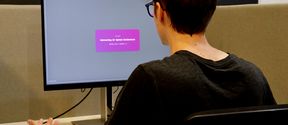Making colours out of gold and DNA

Folk belief says there’s a pot of gold at the end of the rainbow, but a new technology is turning that idea on its head – using particles of gold to make colours. With further work, the method developed at Aalto University could herald a new display technology.
The technique uses gold nanocylinders suspended in a gel. The gel only transmits certain colours when lit by polarized light, and the colour depends on the orientation of the gold nanocylinders. In a clever twist, a collaboration led by Anton Kuzyk’s and Juho Pokki’s research groups used DNA molecules to control the orientation of gold nanocylinders in the gel.
‘DNA isn’t just an information carrier – it can also be a building block. We designed the DNA molecules to have a certain melting temperature, so we could basically program the material,’ says Aalto doctoral candidate Joonas Ryssy, the study’s lead author. When the gel heats past the melting temperature, the DNA molecules loosen their grip and the gold nanocylinders change orientation. When the temperature drops, they tighten up again, and the nanoparticles go back to their original position.
The team tested several custom DNA molecules with different melting temperatures to find the best response. With the current system, the technology can produce red and green light. Once further work makes blue light transmission possible, this approach could be used to generate any colour by mixing red, green, and blue.
‘The whole concept – the underlying philosophy behind the work – is to use simple methods, simple materials and simple tools to generate colours in a dynamic and reversible way,’ says Sesha Manuguri, a postdoctoral researcher at Aalto who led the study.
For Manuguri, part of the elegance of the technique is that the gold nanocylinders accomplish both the necessary tasks. ‘The gold nanorods get hot when they’re lit, heating the gel, and they’re also responsible for colour formation. So, you don’t need separate heating elements,’ he says.
With further development, this approach could be used to produce colour in different kinds of displays. Because the materials are all biocompatible, this could be ideal for displays on wearable sensor devices, but the technology could also be used in billboards or other displays.
‘We’ve done the basic science to bring these building blocks together in a symbiotic manner to create something functional. Now it’s up to engineers to explore what kind of devices could be made,’ says Manuguri.
Further Information
The full paper is available in Advanced Functional Materials.
- Published:
- Updated:
Read more news

Aalto Open Science Award ceremony brought together Aaltonians to discuss open science
Last week we gathered at A Grid to celebrate the awardees of the Aalto Open Science Award 2023 and discuss open science matters with the Aalto community.
Seed funding available to boost collaboration between Aalto, KU Leuven and University of Helsinki
Aalto University, KU Leuven and the University of Helsinki launch the 2nd exploratory seed funding call to explore research collaboration possibilities. The funding call is open until 10 September 2024.
Aalto ARTS Summer School explores the significance of water through the lens of art
The theme of School of Arts, Design and Architecture’s Summer School this year is water, and its significance is explored in a multidisciplinary way through the perspectives of art, film and digital.